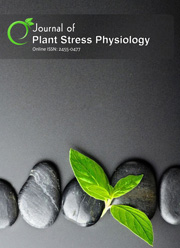Effect of NaCl and Na2SO4 salinities and light conditions on seed germination of purslane (Portulaca oleracea Linn.)
DOI:
https://doi.org/10.19071/jpsp.2017.v3.3142Abstract
Portulaca oleracea Linn., commonly known as purslane, is a C4 succulent and salt tolerant weed. The present work was focused on the seed germination of purslane under different levels of NaCl and Na2SO4 (25, 50, 100 and 200 mM) salinity along with continuous dark and light conditions. Results indicated that both salinity treatments had negative impact on seed germination under both light conditions. Interestingly, seed germination percentage of purslane was high under both salinity treatments and continuous light conditions as compared to dark conditions. The differential response of purslane’s seed germination under NaCl and Na2SO4 salinity and light conditions suggests weediness of this plant under adverse environmental conditions. The present work might be helpful for agricultural practices dealing with the problem of this weed.
Downloads
References
Azooz MM, Ahmad P. eds. Front Matter, In: Legumes under environmental stress: Yield, improvement and adaptations, John Wiley & Sons, Ltd, Chichester, UK.;2015.
Chauhan BS, Johnson DE. Seed germination ecology of Portulaca oleracea L.: an important weed of rice and upland crops. Ann Appl Biol 2009;155:61–69.
Gulzar S, and Khan MA. Seed germination of a halophytic grass Aeluropus lagopoides. Ann Bot 2001;87(3): 319-24.
Houle G, Morel L, Reynolds CE, Siegel J. The effect of salinity on different developmental stages of an endemic annual plant, Aster laurentianus (Asteraceae). Am J Bot 2001;88(1): 62-67.
Huang Z, Zhang X, Zheng G, Gutterman Y. Influence of light, temperature, salinity and storage on seed germination of Haloxylon ammodendron. J Arid Environ 2003;55(3): 453-64.
Khan MA, Gul B, Weber DJ. Germination responses of Salicornia rubra to temperature and salinity. J Arid Environ2000;45(3): 207-14.
Liu L, Howe P, Zhou YF, Xu ZQ, Hocart C, and Zhang R. Fatty acids and β-carotene in Australian purslane (Portulaca oleracea) varieties. J Chromatogr A 2000; 893:207-13.
Oh E, Yamaguchi S, Kamiya Y, Bae G, Chung WI, Choi G. Light activates the degradation of PIL5 protein to promote seed germination through gibberellin in Arabidopsis. The Plant Journal 2006; 47(1): 124-39.
Pessarakli M. ed. Introduction, In: Handbook of plant and crop stress. 3rd Edition, CRC Press, USA.;2010.
Rahdari P, Tavakoli S, Hosseini SM. Studying of salinity stress effect on germination, proline, sugar, protein, lipid and chlorophyll content in purslane (Portulaca oleracea L.) leaves. J Stress Physiol Biochem 2012;8(1): 182-93.
Simopoulos AP. Omega-3 fatty acids and antioxidants in edible wild plants. Biol Res 2004; 37:263-77.
Singh KP. Effect of temperature and light on seed germination of two ecotypes of Portulaca oleracea L. New Phytol 1973;72(2):289-95.
Zia S, Khan MA. Effect of light, salinity, and temperature on seed germination of Limonium stocksii. Can J Bot 2004;82(2): 151-57.






 .
.